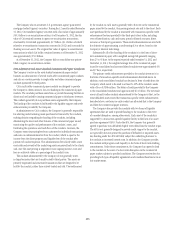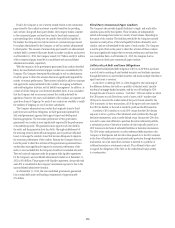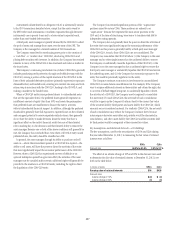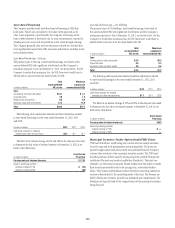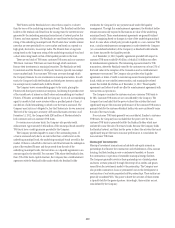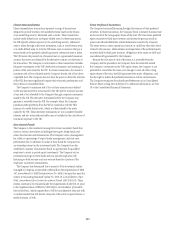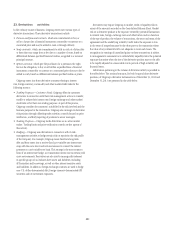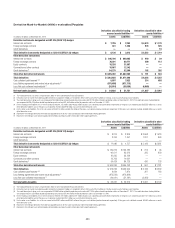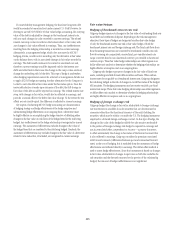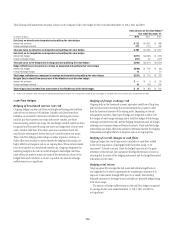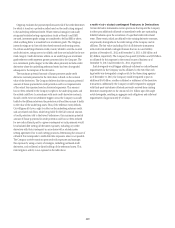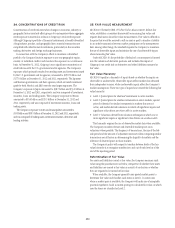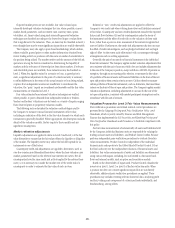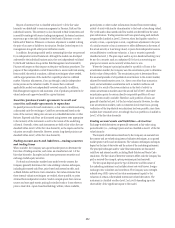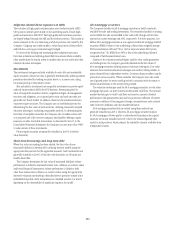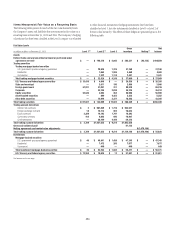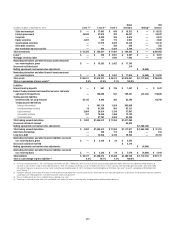Citibank 2012 Annual Report Download - page 267
Download and view the complete annual report
Please find page 267 of the 2012 Citibank annual report below. You can navigate through the pages in the report by either clicking on the pages listed below, or by using the keyword search tool below to find specific information within the annual report.245
For asset/liability management hedging, the fixed-rate long-term debt
would be recorded at amortized cost under current U.S. GAAP. However, by
electing to use ASC 815 (SFAS 133) fair value hedge accounting, the carrying
value of the debt is adjusted for changes in the benchmark interest rate,
with any such changes in value recorded in current earnings. The related
interest-rate swap is also recorded on the balance sheet at fair value, with
any changes in fair value reflected in earnings. Thus, any ineffectiveness
resulting from the hedging relationship is recorded in current earnings.
Alternatively, a management hedge, which does not meet the ASC 815
hedging criteria, would involve recording only the derivative at fair value
on the balance sheet, with its associated changes in fair value recorded in
earnings. The debt would continue to be carried at amortized cost and,
therefore, current earnings would be impacted only by the interest rate
shifts and other factors that cause the change in the swap’s value and may
change the underlying yield of the debt. This type of hedge is undertaken
when hedging requirements cannot be achieved or management decides not
to apply ASC 815 hedge accounting. Another alternative for the Company is
to elect to carry the debt at fair value under the fair value option. Once the
irrevocable election is made upon issuance of the debt, the full change in
fair value of the debt would be reported in earnings. The related interest rate
swap, with changes in fair value, would also be reflected in earnings, and
provides a natural offset to the debt’s fair value change. To the extent the two
offsets are not exactly equal, the difference is reflected in current earnings.
Key aspects of achieving ASC 815 hedge accounting are documentation
of hedging strategy and hedge effectiveness at the hedge inception and
substantiating hedge effectiveness on an ongoing basis. A derivative must
be highly effective in accomplishing the hedge objective of offsetting either
changes in the fair value or cash flows of the hedged item for the risk being
hedged. Any ineffectiveness in the hedge relationship is recognized in current
earnings. The assessment of effectiveness excludes changes in the value of
the hedged item that are unrelated to the risks being hedged. Similarly, the
assessment of effectiveness may exclude changes in the fair value of a derivative
related to time value that, if excluded, are recognized in current earnings.
Fair v alue Hedges
Hedging of benchmark interest rate risk
Citigroup hedges exposure to changes in the fair value of outstanding fixed-rate
issued debt and certificates of deposit. Depending on the risk management
objectives, these types of hedges are designated as either fair value hedges
of only the benchmark interest rate risk or fair value hedges of both the
benchmark interest rate and foreign exchange risk. The fixed cash flows from
those financing transactions are converted to benchmark variable-rate cash
flows by entering into, respectively, receive-fixed, pay-variable interest rate
swaps or receive-fixed in non-functional currency, pay variable in functional
currency swaps. These fair value hedge relationships use either regression or
dollar-offset ratio analysis to determine whether the hedging relationships are
highly effective at inception and on an ongoing basis.
Citigroup also hedges exposure to changes in the fair value of fixed-rate
assets, including available-for-sale debt securities and loans. When certain
interest rates do not qualify as a benchmark interest rate, Citigroup designates
the risk being hedged as the risk of changes in overall fair value of the hedged
AFS securities. The hedging instruments used are receive-variable, pay-fixed
interest rate swaps. These fair value hedging relationships use either regression
or dollar-offset ratio analysis to determine whether the hedging relationships
are highly effective at inception and on an ongoing basis.
Hedging of foreign exchange risk
Citigroup hedges the change in fair value attributable to foreign-exchange
rate movements in available-for-sale securities that are denominated in
currencies other than the functional currency of the entity holding the
securities, which may be within or outside the U.S. The hedging instrument
employed is a forward foreign-exchange contract. In this type of hedge, the
change in fair value of the hedged available-for-sale security attributable
to the portion of foreign exchange risk hedged is reported in earnings and
not Accumulated other comprehensive income—a process that serves
to offset substantially the change in fair value of the forward contract that
is also reflected in earnings. Citigroup considers the premium associated
with forward contracts (differential between spot and contractual forward
rates) as the cost of hedging; this is excluded from the assessment of hedge
effectiveness and reflected directly in earnings. The dollar-offset method is
used to assess hedge effectiveness. Since that assessment is based on changes
in fair value attributable to changes in spot rates on both the available-for-
sale securities and the forward contracts for the portion of the relationship
hedged, the amount of hedge ineffectiveness is not significant.


